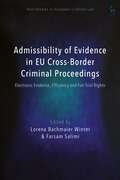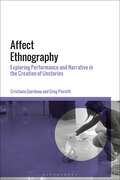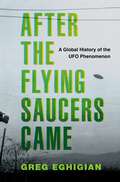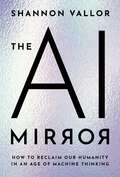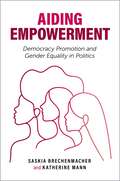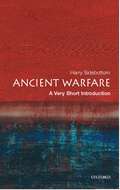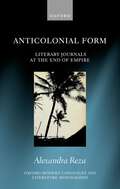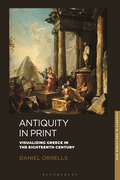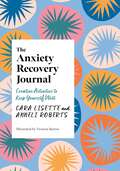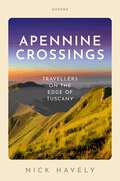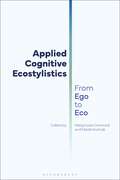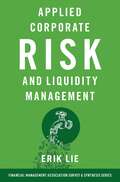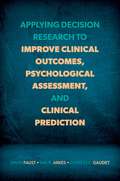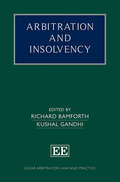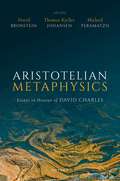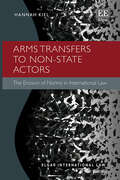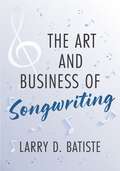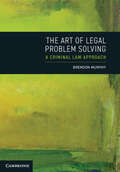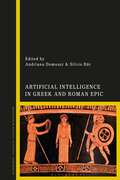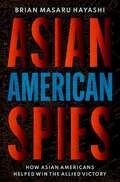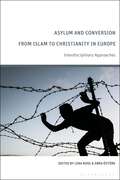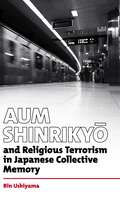- Table View
- List View
Admissibility of Evidence in EU Cross-Border Criminal Proceedings: Electronic Evidence, Efficiency and Fair Trial Rights (Hart Studies in European Criminal Law)
This book provides a systematic and analytical account of the problems facing transnational criminal justice.It details actual problems arising in the transnational prosecution of crimes; assesses existing obstacles on admissibility of evidence; in particular with regard to electronic evidence, assesses the impact that the impediment of free circulation of evidence has on fundamental rights of the defendants facing criminal trial; and finally drafts a proposal for the future of regulation for this complex topic.The book therefore contributes to the debate on the creation of an Area of Freedom, Security and Justice in the EU. It offers insights on how to outline the main general rules that could be adopted at EU level in a manner that adequately balances the need for efficiency in prosecution and the protection of human rights.With contributions of renowned experts in the field, the book addresses the discussion of a potential legislative proposal with the help of insight into the experience and conceptual context of the rules of evidence at the national level. The legislative proposal was adopted by the European Law Institute, who supported the work reflected in this book.
Affect Ethnography: Exploring Performance and Narrative in the Creation of Unstories
by Dr Cristiana Giordano Dr Greg PierottiPlaying with the relation between truth and representation in the stories we tell as ethnographers and theater makers, this book contributes to the current debates around experimental research methodologies and ethnographically grounded theatrical forms. It departs from other studies by proposing a unique and accessible methodology that brings together theatrical devising practices and anthropology. Through its theoretical exploration and performative script, the book bridges the relation between ethnographic writing and performativity, and simultaneously troubles conventional narrative practices in theater and anthropology. The practice described in the book, Affect Theater, also emphasizes embodied and affective approaches to empirical research and defines a process for rendering this type of material into imaginative academic writing, collaborative performance, and other inventive forms, applicable across a range of academic disciplines.
After the Flying Saucers Came: A Global History of the UFO Phenomenon
by Greg EghigianRoswell, 1947. Washington, DC, 1952. Quarouble, 1954. New Hampshire, 1961. Pascagoula, 1973. Petrozavodsk, 1977. Copley Woods, 1983. Explore how sightings of UFOs and aliens seized the world's attention and discover what the fascination with flying saucers and extraterrestrial visitors says about our changing views on science, technology, and the paranormal. In the summer of 1947, a private pilot flying over the state of Washington saw what he described as several pie pan-shaped aircraft traveling in formation at remarkably high speed. Within days, journalists began referring to the objects as "flying saucers." Over the course of that summer, Americans reported seeing them in the skies overhead. News quickly spread, and within a few years, flying saucers were being spotted across the world. The question on everyone's mind was, what were they? Some new super weapon in the Cold War? Strange weather patterns? Optical illusions? Or perhaps it was all a case of mass hysteria? Some, however, concluded they could only be one thing: spacecrafts built and piloted by extraterrestrials. The age of the unidentified flying object, the UFO, had arrived. Greg Eghigian tells the story of the world's fascination with UFOs and the prospect that they were the work of visitors from outer space. While accounts of great wonders in the sky date back to antiquity, reports of UFOs took place against the unique backdrop of the Cold War and space age, giving rise to disputed government inquiries, breathtaking news stories, and single-minded sleuths. After the Flying Saucers Came traces how a seemingly isolated incident sparked an international drama involving shady figures, questionable evidence, suspicions of conspiracy, hoaxes, new religions, scandals, unsettling alien encounters, debunkers, and celebrities. It examines how descriptions, theories, and debates about unidentified flying objects and alien abduction changed over time and how they appeared in the United States, Europe, Latin America, Asia, and Russia. And it explores the impact UFOs have had on our understanding of space, science, technology, and ourselves up through the present day. Replete with stories of the people who have made up the ufology community, the military and defense units that investigate them, the scientists and psychologists who have researched these unexplained encounters, and the many novels, movies, TV shows, and websites that have explored these phenomena, After the Flying Saucers Came speaks to believers and skeptics alike.
The AI Mirror: How to Reclaim Our Humanity in an Age of Machine Thinking
by Shannon VallorFor many, technology offers hope for the future?that promise of shared human flourishing and liberation that always seems to elude our species. Artificial intelligence (AI) technologies spark this hope in a particular way. They promise a future in which human limits and frailties are finally overcome?not by us, but by our machines. Yet rather than open new futures, today's powerful AI technologies reproduce the past. Forged from oceans of our data into immensely powerful but flawed mirrors, they reflect the same errors, biases, and failures of wisdom that we strive to escape. Our new digital mirrors point backward. They show only where the data say that we have already been, never where we might venture together for the first time. To meet today's grave challenges to our species and our planet, we will need something new from AI, and from ourselves. Shannon Vallor makes a wide-ranging, prophetic, and philosophical case for what AI could be: a way to reclaim our human potential for moral and intellectual growth, rather than lose ourselves in mirrors of the past. Rejecting prophecies of doom, she encourages us to pursue technology that helps us recover our sense of the possible, and with it the confidence and courage to repair a broken world. Vallor calls us to rethink what AI is and can be, and what we want to be with it.
Aiding Empowerment: Democracy Promotion and Gender Equality in Politics (Carnegie Endowment for International Peace)
by Saskia Brechenmacher Katherine MannIn recent decades, women's political empowerment has become an important foreign policy and assistance objective. Every year, donor governments and multilateral organizations partner with hundreds of civil society groups around the world to train women to run for office, support women legislators, campaign for gender quotas, and bolster women's networks in political parties and parliaments. What ideas about gender, power, and political change guide these aid programs? What have practitioners and advocates learned about their strengths and weaknesses, and how might they improve their work going forward? Drawing on extensive interviews with aid officials, women's rights advocates, and women politicians in Western donor countries and across Kenya, Morocco, Myanmar, and Nepal, Aiding Empowerment investigates how democracy aid actors promote gender equality in politics. Saskia Brechenmacher and Katherine Mann argue that international assistance for women's political empowerment has evolved significantly over the last three decades, from a first generation of aid programs aimed at integrating women into nascent democratic institutions to a second generation focused on transforming the broader political ecosystem hindering women's equal political influence. However, this evolution is still unfolding, and changes in thinking have outstripped changes in aid practice. Several challenges threaten future progress, from the persistence of patriarchal norms to rising concerns about democratic erosion and backlash. In the face of these hurdles, the book presents practical recommendations for policymakers, practitioners, and advocates fighting for women's political empowerment globally.
Ancient Warfare: A Very Short Introduction (Very Short Introductions)
by Harry SidebottomGreek and Roman warfare differed from other cultures and was unlike any other forms of warfare before and after. The key difference is often held to be that the Greeks and Romans practised a 'Western Way of War', where the aim is an open, decisive battle, won by courage instilled in part by discipline. Harry Sidebottom looks at how and why this 'Western Way of War' was constructed and maintained by the Greeks and Romans, why this concept is so popular and prevalent today, and at whether or not this is an accurate interpretation. All aspects of ancient warfare are thoroughly examined - from philosophy and strategy to the technical skills needed to fight. He looks at war in the wider context - how wars could shape classical society, and how the individual's identity could be constructed by war, for example the Christian soldier fighting in God's name. He also explores the ways in which ancient society thought about conflict: Can a war be just? Why was siege warfare particularly bloody? What role did divine intervention play in the outcome of a battle? Taking fascinating examples from the Iliad, Tacitus, and the Persian Wars, Sidebottom uses arresting anecdotes and striking visual images to show that the any understanding of ancient war is an ongoing process of interpretation. ABOUT THE SERIES: The Very Short Introductions series from Oxford University Press contains hundreds of titles in almost every subject area. These pocket-sized books are the perfect way to get ahead in a new subject quickly. Our expert authors combine facts, analysis, perspective, new ideas, and enthusiasm to make interesting and challenging topics highly readable.
Anticolonial Form: Literary Journals at the End of Empire (Oxford Modern Languages and Literature Monographs)
by Alexandra RezaAnticolonial Form: Literary Journals at the End of Empire addresses the relationship between culture and politics in two journals published in Europe by African writers: Pr?sence Africaine, launched in Paris in 1947, and Mensagem, published between 1948 and 1964 in Lisbon. Grounded in extensive archival work, the book argues for a comparative and transnational approach to postcolonial literary studies, for the significance of the literary journal as a key form in the development of African writing in French, Portuguese, and English, and for a historically and geographically contingent understanding of the relationships between literature, culture, and politics. This book takes up the idea of articulation to bring forward the contingent and fugitive connections that networks of literary journals fostered between francophone, anglophone, and lusophone writers in the conjuncture of decolonization in the 1950s and 1960s. It argues that comparison as a praxis and a method was central to the anticolonial charge of those journals, on whose pages we see an iterative back and forth between writing from and about different parts of the colonial world, a recursive effort to establish how ideas and analyses developed in one part of the colonial world could travel, and be adopted and adapted in others Many scholars have argued convincingly that the institutionalized practice of comparison in the academic field of comparative literature is itself imbricated with histories of colonialism. Reza's argument takes on a particular significance in the context of that critique as the anticolonial comparison on which she focuses offers a different tradition of relational praxis from which to think about connection and comparison itself.
Antiquity in Print: Visualizing Greece in the Eighteenth Century (New Directions in Classics)
by Daniel OrrellsDaniel Orrells examines the ways in which the ancient world was visualized for Enlightenment readers, and reveals how antiquarian scholarship emerged as the principal technology for envisioning ancient Greek culture, at a time when very few people could travel to Greece which was still part of the Ottoman Empire. Offering a fresh account of the rise of antiquarianism in the 18th century, Orrells shows how this period of cultural progression was important for the invention of classical studies. In particular, the main focus of this book is on the visionary experimentalism of antiquarian book production, especially in relation to the contentious nature of ancient texts. With the explosion of the Quarrel between the Ancients and the Moderns, eighteenth-century intellectuals, antiquarians and artists such as Giambattista Vico, Johann Joachim Winckelmann, the Comte de Caylus, James Stuart, Julien-David Leroy, Giovanni Battista Piranesi and Pierre-François Hugues d'Hancarville all became interested in how printed engravings of ancient art and archaeology could visualize a historical narrative. These figures theorized the relationship between ancient text and ancient material and visual culture - theorizations which would pave the way to foundational questions at the heart of the discipline of classical studies and neoclassical aesthetics.
Anxiety and Related Disorders Interview Schedule for DSM-5, Child and Parent Version: Parent Interview Schedule - 5 Copy Set (PROGRAMS THAT WORK)
by Anne Marie Albano Wendy K. SilvermanThe Anxiety Disorders Interview Schedule for DSM-5, Child and Parent Versions, are the gold standard semi-structured interviews used in clinical research and services to assess and diagnose the major mental health conditions affecting children, adolescents and young adults. These interviews cover the range of conditions identified in the Diagnostic and Statistical Manual of Mental Disorders (DSM), while also providing information for careful case formulation in treatment planning and evaluation of outcomes. Evaluators are able to quantify the severity of illness using a Clinician Severity Rating (CSR), as well as level of severity of symptoms and associated avoidance behavior. Decision rules for combining parent and youth reports, examples of CSR levels for the child anxiety triad of separation anxiety disorder, social anxiety disorder, and generalized anxiety disorder are included in the Clinician Guide. Price is for a set of 5 Parent Interview Schedules.
The Anxiety Recovery Journal: Creative Activities to Keep Yourself Well (Creative Journals for Mental Health)
by Cara Lisette Anneli RobertsThe Anxiety Recovery Journal is designed to support you in managing your feelings of anxiety. Drawing on evidence-based techniques, such as CBT, and on the authors' professional and lived experience, it features helpful journaling prompts, creative activities, beautiful colouring pages and motivational quote pages to help you calm your anxious mind.This uplifting journal will help you better understand your experiences of anxiety and motivate you in your recovery journey. Created by CBT therapist Cara Lisette and mental health advocate Anneli Roberts, the activities in this journal will help you to take positive steps towards living a full life beyond your anxiety.
Apennine Crossings: Travellers on the Edge of Tuscany
by Nick Havely'The Apennines are Italy' exclaimed The Examiner two centuries ago, yet this unique region and its striking literary and cultural connections are underappreciated in the English-speaking world. Apennine Crossings: Travellers on the Edge of Tuscany links a twenty-first century journey in the mountains of Northern Italy to past writers, routes, and travellers. It follows the modern long-distance walking trail of the 'Great Apennine Excursion', whilst moving back and forth in time: from the Middle Ages to World War Two and from the journeys of pilgrims, merchants, and tourists to those of soldiers, partisans, and poets. Stories of past travellers in the region continually intersect with a contemporary account of a walk across the ridge of the Northern Apennines. Alongside Nick Havely's present-day narrator and traveller, the cast of characters includes major writers and poets, such as Dante, Montaigne, Goethe, Shelley, and Stendhal, together with a multitude of less well-known figures whose journeys, experiences, and responses cast new light on a landscape that is close to yet remote from the sites typically visited by modern travellers to Italy. Havely draws these earlier travellers' stories from a wide range of published and unpublished sources such as letters, journals, memoirs, poems, and interviews. Together, they illustrate several significant themes: the histories of mountain passes, remote lakes, and ancient sanctuaries; perceptions of the mountains; the social and religious culture of the Northern Apennines; the preoccupations of literary tourism; the impact of campaigns and conflict during World War Two; and the effects of depopulation and deforestation. The Apennine region features in its full literary, historical, and cultural richness. Included are twenty-six illustrations, with maps for the whole route and for the sections covered by each of the book's seven chapters.
Applied Cognitive Ecostylistics: From Ego to Eco
This book offers an up-to-date account of one of the most influential strands of eco-research: cognitive ecostylistics. The onset of the 1970s saw a global shift in scholarly perspective upon the relation between egocentric and ecocentric views of the world. The so-called eco-turn was not only linguistic at its roots, but engaged the bulk of academic thought in social sciences and humanities. Cognitive ecostylistics invites a multidisciplinary approach to the study of the conceptual relations between oral or written texts and their impact on the environment. This volume is a collection of the latest research that seeks to apply the theory and methodology developed over the last 40 years to both literary and real-life texts, engaging with a wealth of examples from First World War poetry and Anne of Green Gables through to Condé Nast Traveller hotel descriptions. Exploring the cultural effects of the eco-turn, the collection engages the reader in the problem of the present-day Anthropocene, manifested as Ego-Eco tensions at the level of communicating self-needs and the needs of the Other. Divided into two parts, it considers first the human-angled semiotic interplay contained within the universe of people, before examining the problem of semiotic engagement of texts as extraneous to the human, highlighting crucial aspects of nature, culture, and beyond.
Applied Corporate Risk and Liquidity Management (FINANCIAL MGMT ASSOC SURVEY SYN SERIES)
by Erik LieCash holdings play a critical role for all corporations. They serve as a source of funding for investment projects that create value for shareholders and as a cushion against costly financial distress. On the other hand, excess cash holdings can induce wasteful spending and attract unwanted attention from labor unions and activist investors. In Applied Corporate Risk and Liquidity Management, Erik Lie brings risk management and liquidity management together to explore how corporations can ensure they have sufficient--but not excess--cash holdings, both now and in the future. He begins by covering the determinants of liquidity, the consequences of suboptimal liquidity, and how to manage liquidity. Lie then demonstrates two ways to control current and future cash holdings: the mitigation of risk factors on operating cash flow and cash holdings and the payouts made to investors. Through this integrated approach, he explores how risk management and payout policy can and should be used to maintain the proper cash level. Using cash simulations throughout, Lie shows how to determine whether firms should hedge, which hedging mechanism to use, and which payout mechanism or debt structure is suitable. With practical tools rooted in liquidity management, this book presents a strong theoretical foundation for risk management and payout policy, discusses practical considerations, and demonstrates applied tools that help managers make good decisions.
Applied Yoga™ for Musculoskeletal Pain: Integrating Yoga, Physical Therapy, Strength, and Spirituality
by Jory SerotaThis innovative and evidence-based book provides practical and transformative guidance on how to help clients struggling with chronic and acute musculoskeletal pain through yoga and remedial exercise. Using a holistic framework that addresses the physical, mental and emotional challenges of chronic pain, Jory Serota offers a wide range of tools yoga therapists and bodyworkers can use to empower clients and help them work with their bodies intuitively.It includes photographs with step-by-step instructions for practice, all of which include adaptations to meet a range of ability and mobility. Common areas of chronic pain are discussed in depth, including the lower back, knees, hips, sacroiliac joint and glutes, shoulders, and neck, allowing practitioners to address specific concerns and maximise healing.Practitioners will benefit from full yoga sequences and will be able to expand their offering by practically and confidently addressing the widespread struggle of chronic musculoskeletal pain.
Applying Decision Research to Improve Clinical Outcomes, Psychological Assessment, and Clinical Prediction
by David Faust Hal R. Arkes Charles E. GaudetMental health professionals often make explicit or implicit predictions involving crucial matters--Is a client at risk for self-harm or harming others? What treatment approach is most likely to be successful? Has a child been subjected to sexual or physical abuse? Decision research has particularly strong applied use for improving the accuracy of such determinations; unfortunately this work has not been broadly disseminated in the mental health field. Applying Decision Research to Improve Clinical Outcomes, Psychological Assessment, and Clinical Prediction introduces graduate students and practitioners in the mental health field to research, knowledge, and practical strategies that can enhance diagnostic and predictive accuracy and thereby improve client care. Major chapters of the book address well-established, but often under-recognized, principles and procedures for improving the integration of clinical data and interpretive accuracy; the differentiation between seemingly accurate but illusory, as opposed to genuine, associations between signs, symptoms, and outcomes; and the minimization of impediments to accurate decision making. The authors merge applied clinical tasks in the mental health field with decision research and cognitive psychology to suggest ways in which prediction, diagnosis, and assessment can be accomplished with greater efficacy and precision.
Arbitration and Insolvency (Elgar Arbitration Law and Practice series)
The worlds of insolvency and international arbitration have an inherent collision course, coming as they do from very different perspectives but as the business world faces an increasing number of challenges, we are having to look far more closely at how the two co-exist and work together. Richard Bamforth and Kushal Gandhi lead a team of experts from across the two disciplines to consider the effect of insolvency on arbitration agreements; the developing legal theories on the types of matters which are capable of being arbitrated; the issues arising from party insolvency during the course of ongoing arbitral proceedings; and how insolvency affects a person’s ability to enforce their arbitral award. Key Features:Examines international perspectives on insolvency proceedingsInvestigates the New York Convention 1958, the Insolvency Act 1986 and the Arbitration Act 1996Assesses whether insolvency is a procedural or substantive matter for the purposes of arbitrationProvides practical guidance on the commencement of insolvency proceedings for an arbitrable debtAnalyses the impact of foreign insolvencies on England-seated arbitration and English statutory adjudicationInsolvency and arbitration lawyers will find this book to be a fundamental resource. It will also be beneficial for scholars of arbitration and dispute resolution, company and insolvency law, corporate law, and litigation.
Aristotelian Metaphysics: Essays in Honour of David Charles
by David Bronstein Thomas Kjeller Johansen Michail PeramatzisThis volume provides a rich collection of original essays on Aristotle's metaphysics written by sixteen prominent scholars in the field. Honouring the seminal influence of David Charles to philosophical scholarship, it offers fresh interpretations and assessments of Aristotle's thinking in metaphysics and related areas such as philosophy of language, psychology, natural philosophy, and mathematics. The collection contributes to the recent resurgence of interest in Aristotelian metaphysics, furthering our understanding of Aristotle's seminal contribution to the history of western philosophy. It evaluates key features of Aristotle's metaphysical thinking: his accounts of definition and meaning; his understanding of being and the categories; his models of explanation, causation, and accounts of modality, space, and change. The chapters are written with clarity and attention to the detail of Aristotle's texts but presuppose no knowledge of ancient Greek and can be read with benefit by advanced philosophy students and scholars.
Arms Transfers to Non-State Actors: The Erosion of Norms in International Law (Elgar International Law series)
by Hannah KielThis insightful book analyses the issue of norm erosion in international law by examining arms transfers to non-state actors. Balancing empirical research with legal theory, the author dissects recent case studies, tracing individual changes in norms against a background of systemic transformation.Arms Transfers to Non-State Actors follows changes in the prohibition of arms transfers to non-state actors since the pivotal International Court of Justice's Nicaragua ruling in 1986. Hannah Kiel critically discusses the legal developments through relevant case studies, including Abkhazia, Bosnia, Congo, Eastern Ukraine, Kosovo, Libya, Northern Iraq, South Ossetia, Syria and Yemen. Adopting a customary law perspective while also placing the narratives of states in the context of international structural changes, Kiel emphasises the interplay between state practice and the strengthening of a human rights-based paradigm. Kiel ultimately shows that changes in norms at the individual level indicate a larger transformation in the international order, and while the arming of non-state actors remains formally illegal, the prohibition of this practice is informally eroding.Interdisciplinary in scope, this book provides valuable insights for scholars and researchers of public international law, human rights, international humanitarian law, and international relations. It is also of great benefit to human rights lawyers, policymakers, and diplomats.
The Art and Business of Songwriting
by Larry D. BatisteIn this valuable resource guide for both beginners and professionals, veteran songwriter, producer, arranger, vocalist, music director, and educator Larry D. Batiste shares practical advice and tips from his decades of experience in ways that are bound to help all readers improve their songwriting skills. Through this book, readers will learn the craft of professional songwriting, including the ins-and-outs of song structure, lyric and melody writing, and the essential elements of a hit song. From the start, Batiste incorporates exercises to help songwriters strike upon ideas for song titles, concepts, and stories that will appeal to their audience. He also discusses critical business aspects of songwriting, such as copyrighting, publishing, royalties, networking, and digital media. In addition to the fundamentals, the reader will learn how to build their songwriting career, generate income, build an online community and fanbase, release music independently, expertly place their songs, and navigate the world of digital music. Throughout the book are interviews with iconic songwriters and producers such as Peter Asher, Lamont Dozier, and Narada Michael Walden, as well as independent recording artists, including Fantastic Negrito, a winner of multiple Grammy Awards, and Meklit Hadero. Understanding the artistic and business aspects of songwriting is essential for a successful career in the music industry. The Art and Business of Songwriting can be applied to every genre of popular music and is written to encourage, motivate, and unlock the idiosyncrasies of the business for music professionals as much as for beginners.
The Art and Craft of International Environmental Law
by Daniel Bodansky Harro van AsseltIn countless ways we are affected by international environmental norms: some social, others legal; some quite general, others very specific. For example, the norms limiting the refrigerants used in air conditioners have been agreed upon in legal form internationally, and are mandated and enforced by national governments. The sustainable fishery and forestry standards used by Carrefour and Ikea were developed more informally by environmental groups and businesses, and are applied to producers through supply-chain contracts, without any government involvement. The reluctance to eat tuna fish or own elephant ivory reflects more general social norms, disseminated through education and culture. How and why do these norms arise? In what ways do they affect behavior? Do they change what states and individuals actually do and, if so, why? How effective are they in solving international environmental problems? In the second edition of The Art and Craft of International Environmental Law, Daniel Bodansky and Harro van Asselt explore these and other questions. Revisions cover the numerous developments spanning the 13 years since the first edition was published. New chapters address the growing role of environmental NGOs and the increasingly complex architecture of environmental law involving multiple institutions, levels of governance, and actors. Recent research has been incorporated on treaty design and policy implementation and effectiveness, and greater attention has been given to the role of the judiciary in standard-setting, implementation, and enforcement. A sophisticated yet highly readable introduction to how international environmental law works (and sometimes doesn't work), this book is essential reading for a wide audience.
The Art of Legal Problem Solving: A Criminal Law Approach
by null Brendon MurphyThe Art of Legal Problem Solving: A Criminal Law Approach is a sophisticated skills book designed to help students develop the problem-solving techniques necessary for their legal careers. This succinct yet comprehensive book provides the perfect mix of general instruction and specific examples to encourage students to think about problems both in depth and broadly. It follows a clear roadmap presented in a logical progression, beginning with the fundamentals, fact finding and statutory interpretation before turning to the advanced areas of analysing and writing answers to problem questions. While written primarily for criminal law students, the skills imparted are generic and can be applied equally in any area of the law and in any jurisdiction. The Art of Legal Problem Solving is an indispensable work for law students who want to not only improve their problem-solving skills but master them.
Artificial Intelligence in Greek and Roman Epic
This is the first scholarly exploration of concepts and representations of Artificial Intelligence in ancient Greek and Roman epic, including their reception in later literature and culture. Contributors look at how Hesiod, Homer, Apollonius of Rhodes, Moschus, Ovid and Valerius Flaccus crafted the first literary concepts concerned with automata and the quest for artificial life, as well as technological intervention improving human life.Parts one and two consider, respectively, archaic Greek, and Hellenistic and Roman, epics. Contributors explore the representations of Pandora in Hesiod, and Homeric automata such as Hephaestus' wheeled tripods, the Phaeacian king Alcinous' golden and silver guard dogs, and even the Trojan Horse. Later examples cover Artificial Intelligence and automation (including Talos) in the Argonautica of Apollonius and Valerius Flaccus, and Pygmalion's ivory woman in Ovid's Metamorphoses. Part three underlines how these concepts benefit from analysis of the ekphrasis device, within which they often feature. These chapters investigate the cyborg potential of the epic hero and the literary implications of ancient technology. Moving into contemporary examples, the final chapters consider the reception of ancient literary Artificial Intelligence in contemporary film and literature, such as the Czech science-fiction epic Starvoyage, or Small Cosmic Odyssey by Jan Kr?esadlo (1995) and the British science-fiction novel The Holy Machine by Chris Beckett (2004).
Asian American Spies: How Asian Americans Helped Win the Allied Victory
by Brian Masaru HayashiA recovery of the vital role Chinese, Japanese, and Korean Americans played in US intelligence services in Asia during World War II. Spies deep behind enemy lines; double agents; a Chinese American James Bond; black propaganda radio broadcasters; guerrilla fighters; pirates; smugglers; prostitutes and dancers as spies; and Asian Americans collaborating with Axis Powers. All these colorful individuals form the story of Asian Americans in the Office of Strategic Services (OSS), the forerunner of today's CIA. Brian Masaru Hayashi brings to light for the first time the role played by Chinese, Japanese, and Korean Americans in America's first centralized intelligence agency in its fight against the Imperial Japanese forces in east Asia during World War II. They served deep behind enemy lines gathering intelligence for American and Chinese troops locked in a desperate struggle against Imperial Japanese forces on the Asian continent. Other Asian Americans produced and disseminated statements by bogus peace groups inside the Japanese empire to weaken the fighting resolve of the Japanese. Still others served with guerrilla forces attacking enemy supply and communication lines behind enemy lines. Engaged in this deadly conflict, these Asian Americans agents encountered pirates, smugglers, prostitutes, and dancers serving as the enemy's spies, all the while being subverted from within the OSS by a double agent and without by co-ethnic collaborators in wartime Shanghai. Drawing on recently declassified documents, Asian American Spies challenges the romanticized and stereotyped image of these Chinese, Japanese, and Korean American agents--the Model Minority-while offering a fresh perspective on the Allied victory in the Pacific Theater of World War II.
Asylum and Conversion to Christianity in Europe: Interdisciplinary Approaches
Drawing together previously disjointed scholarship on the topic of asylum and conversion from Islam to Christianity, this book shows how boundaries of belonging are negotiated between Middle Eastern ex-Muslim asylum seekers, church representatives, lawyers, legal decision-makers and policymakers. With case studies from European countries such as Germany, Austria, Finland and Sweden, the book takes an interdisciplinary approach including ethnographic and other qualitative research, discourse analysis and case law analysis, to explore the complexities of the phenomenon of asylum and conversion from Islam to Christianity.This book is an authoritative resource for academic scholars in fields as diverse as migration and refugee studies, anthropology, sociology, religious studies, law and socio-legal studies, as well as legal and religious practitioners.
Aum Shinrikyo and religious terrorism in Japanese collective memory (British Academy Monographs)
by Rin UshiyamaAum Shinriky?'s sarin attack on the Tokyo subway in March 1995 left an indelible mark on Japanese society. This is the first book to offer a comprehensive study of the competing memories of Aum Shinriky?'s religious terrorism. Developing a sociological framework for how uneven distributions of power and resources shape commemorative processes, this book explores how the Aum Affair developed as a 'cultural trauma' in Japanese collective memory following the Tokyo attack. Interrogating an array of sources including mass media reports and interviews with victims and ex-members, it reveals the multiple clashing narratives over the causes of Aum's violence, the efficacy of 'brainwashing' and 'mind control', and whether capital punishment is justified. It shows that although cultural trauma construction requires the use of moral binaries such as 'good vs. evil', 'pure vs. impure', and 'sacred vs. profane', the entrenchment of such binary codes in commemorative processes can ultimately hinder social repair and reconciliation.
